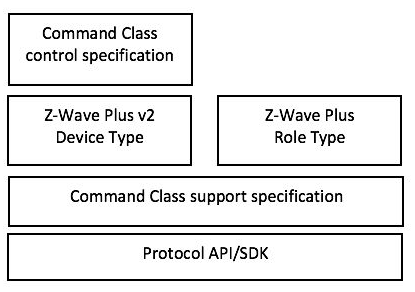Z-Wave Fundamentals#
Z-Wave Specification#
The Z-Wave specification defines the details of Z-Wave communication. The documents are structured in several layers, and each document defines the requirements for a given building block or layer of a Z-Wave application. The specifications that are applicable to a product must be followed to pass certification. Certification is required before a product can be sold on the market.
The main Z-Wave specification page is located at: https://www.silabs.com/wireless/z-wave/specification.
The specifications for Z-Wave Plus v2 devices are shown in the following figure:


All communication within the Z-Wave network is organized into Command Classes. Command Classes are groups of commands and responses related to a certain function of a device.
Command Class Control Specification#
The Command Class Control Specification describes the requirements associated with the control of Z-Wave Command Classes. It contains a list of requirements applying to all Z-Wave compliant nodes controlling a given Command Class.
For more information, see Z-Wave Specifications.
Z-Wave Plus v2 Device Type and Role Type Specifications#
The Z-Wave Plus v2 Device Type and Z-Wave Plus Role Type describe the different types of devices that can be part of a Z-Wave network and the different types of network behavior these devices may adopt. It also standardizes the way in which these devices announce their primary purpose and other capabilities to the rest of the network. When combined, the Device and the Role Type specifications help to ensure devices in the network know how, when, and what to communicate, as well as what to expect from other devices in the network.
For more information, see Z-Wave Specifications.
Together with the Command Class specification, this provides the foundation on which Z-Wave interoperability is built.
Z-Wave Command Class Specification#
The Z-Wave Command Class Specifications describe standardized messages defined in Z-Wave. This is the “language” that Z-Wave devices speak. The various Command Classes define how commands and information are carried to, from, and between devices; for example, the command for switching a light bulb on or how to request the energy metering data from the last 10 minutes that has been gathered by an electrical socket.
For more information, see Z-Wave Specifications.
The following are four types of command classes.
Application command classes define application level functionality supported by any node regardless of device type or role.
Management command classes define node administration and management. These classes may be mandated by the device type or role.
Encapsulation command classes define command classes used to encapsulate other command classes.
Network command classes define functionality related to RF or Z/IP gateway, and controller specific command classes.
For more information, see Z-Wave Specifications.
Protocol API/SDK#
The protocol API/SDK is a software implementation running on Silicon Labs chips. It enables the developer to use the Z-Wave protocol with API functions and therefore build applications quickly. The SDK is distributed in Simplicity Studio.
General Information About Z-Wave#
The following are recommended Z-Wave resources for your first encounter with Silicon Labs Z-Wave products. They provide an overview of the Z-Wave technology, describe available development tools, and can help you to choose the right development kit.
Z-Wave Main page: Z-Wave technology introduction from end-user perspective. Provides a simple overview of the benefits of Z-Wave, typical applications, and available products.
Silicon Labs' Z-Wave products page: Ideal starting point to look for hardware and software resources for Z-Wave product development or to compare different development kits.
Introduction to Z-Wave: Quick technical overview of Z-Wave
Z-Wave 700 Starter Kit Overview: Lists the kit contents and features, relevant technical documents, and the steps for getting started with development.
Z-Wave 800 Pro Kit Overview: Lists the kit contents and features, relevant technical documents, and the steps for getting started with development.
Z-Wave 800 Series Development Kit Overview: Lists the kit contents and features, relevant technical documents and the steps for getting started with development.
